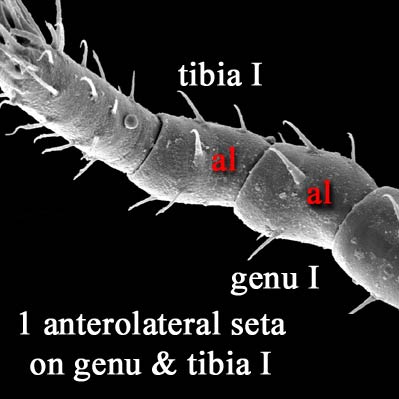Tibia and genu I with 1 al seta
Dorsal shield entire
Sternal shield with 3 pairs of setae
Anus on small anal shield with 3 setae
Deutonymphs often with acrotarsus I
Home | Mesostigmata (Monogynaspida) Home | Glossary
Eviphididae
Taxonomic Position
Cohort Gamasina
Subcohort Dermanyssiae
Superfamily Eviphidoidea
Alliphis Halbert, Canestriniphis Potter & Johnston, Copriphis Berlese, Crassicheles Karg, Evimirus Karg, Eviphis Berlese, Pelethiphis Berlese, Rafaphis Skorupski & Blaszak, Scamaphis Karg, Scarabaspis Womersley, Scarabacariphis Masan, Thinoseius Berlese
Diagnostic characters:
Tibia and genu I with 1 al seta
Dorsal shield entire
Sternal shield with 3 pairs of setae
Anus on small anal shield with 3 setae
Deutonymphs often with acrotarsus I
Similar taxa. The mouthparts of some eviphidoids resemble those of uropodoids.
Diagnosis. Yellow, brownish to bright pink dermanyssine mesostigmatans with holodorsal shields usually bearing 25-30 pairs of setae (17 in Thinoseius), sometimes dome-like. Peritremes generally well developed, shield sometimes produced posteriorly; large glands may be present near stigmata that secrete a viscous substance. Sternal shield (absent in Thinoseius) bearing 3 pairs of setae (st1-3) and 2 pairs of lyrifissures; metasternal shields present with st4 or absent (st4 in soft cuticle); genital shield subrectangular, strap-like or onion-shaped (Evimirus), with 0-1 pair of setae; anal shield with 3 circumanal setae. Tarsus I with claws; trochanter I with 5-6 setae; tibia I with 5/2-3 dorsal/ ventral setae, genu I 5/3; genu IV with 7 setae, 4/1 dorsal/ ventral; coxal spurs are found in Scarabaspis. Chelicerae chelate-dentate or elongate and slender (uropodoid), sometimes with a distal excrescence in the males. Palp genu with 6 setae, palp apotele 2- or 3-tined; corniculi horn-like; subcapitulum with 3-6 rows of denticles. Tritosternum biflagellate with columnar or short, squat base. Tectum with long median process or denticulate. Female sperm induction pores near bases of coxae IV. Males with genital opening at base of tritosternum in sternogenital shield; spermatodactyl usually well developed.
Simplified Key to some genera of Eviphididae
1. Palp genu with 6 setae............................................................................................. 2
- Palp genu with 5 setae............................................................................... Thinoseius
2. Tibia I with 3 ventral setae; 4-6 rows of deutosternal denticles; palp apotele 2-tined.. 3
- Tibia I with 2 ventral setae; 3 rows of deutosternal denticles; palp apotele 3-tined Evimirus
3. Genu III with 2 ventral seta; chelicerae normal.......................................................... 4
- Genu III with 1 ventral seta; chelicerae slender, elongate, with small digits.................... Eviphis
4. Setae on coxae I-II setiform or spine-like................................................................. 5
- Setae on coxae I-II mostly knob-like....................................................... Scarabaspis
5. Peritrematal shield not extending posterior to coxa IV............................................... 6
- Peritrematal shield produced strongly behind coxae IV................................ Copriphis
6. Dorsal shield with 30 pairs of setae; J1 present......................................................... 7
- Dorsal shield with 26 pairs of setae; J1 absent........................................... Scamaphis
7. Vertical setae (j1) elongate and conspicuous............................................................. 8
- Vertical setae (j1) shorts................................................................................. Alliphis
8. Tibia II with 10 setae; genu II with 9 setae.............................................. Crassicheles
- Tibia II with 11 setae; genu II with 10 setae.................................................. Uroiphis
References
Christie JE. 1983. a new species of Alliphis (Mesostigmata: Eviphididae) from Britain. Acarologia 231-242.
Karg W. 1989. Die Arten Raubmilbengattung Evimirus Karg, 1963 (Acarina, Parasitiformes). Dtsch. ent. Z. 36: 165-168.
Karg, W. 1996.
Neue Arten aus Raubmilbengattungen der Gamasina Leach (Acarina, Parasitiformes) mit Indikationen zum Entwicklungsalter. Mitteilungen aus dem Zoologischen Museum in Berlin 72, 149-195.